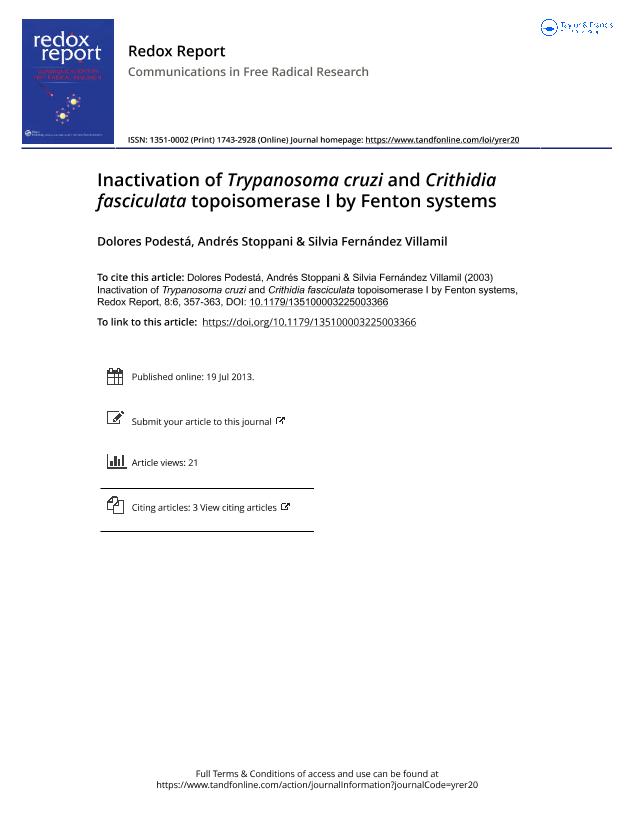Artículo
Inactivation of Trypanosoma cruzi and Crithidia fasciculata topoisomerase I by Fenton systems
Fecha de publicación:
04/2003
Editorial:
Maney Publishing
Revista:
Redox Report
ISSN:
1351-0002
Idioma:
Inglés
Tipo de recurso:
Artículo publicado
Clasificación temática:
Resumen
Fenton systems (H2O2/Fe(II) or H2O2/Cu(II)) inhibited Trypanosoma cruzi and Crithidia fasciculata topoisomerase I activity. About 61-71% inactivation was produced by 25 μM Fe(II) or Cu(II) with 3.0 mM H2O2. Thiol compounds and free radical scavengers prevented Fenton system effects, depending on the topoisomerase assayed. With the T. cruzi enzyme, reduced glutathione (GSH), dithiothreitol (DTT), cysteine and N-acetyl-L-cysteine (NAC) entirely prevented the effect of the H2O2/Fe(II) system; mannitol protected 37%, whereas histidine and ethanol were ineffective. With C. fasciculata topoisomerase, GSH, DTT and NAC protected 100%, cysteine, histidine and mannitol protected 28%, 34% and 48%, respectively, whereas ethanol was ineffective. With the H2O2/Cu(II) system and T. cruzi topoisomerase, DTT and histidine protected 100% and 60%, respectively, but the other assayed protectors were less effective. Similar results were obtained with the C. fasciculata enzyme. Topoisomerase inactivation by the H2O2/Fe(II) or H2O2/Cu(II) systems proved to be irreversible since it was not reversed by the more effective enzyme protectors. It is suggested that topoisomerases could act either as targets of 'reactive oxygen species' (ROS) generated by Fenton systems or bind the corresponding metal ions, whose redox cycling would generate reactive oxygen species in situ.
Palabras clave:
Trypanosomatids
,
Ros
Archivos asociados
Licencia
Identificadores
Colecciones
Articulos(INGEBI)
Articulos de INST.DE INVEST.EN ING.GENETICA Y BIOL.MOLECULAR "DR. HECTOR N TORRES"
Articulos de INST.DE INVEST.EN ING.GENETICA Y BIOL.MOLECULAR "DR. HECTOR N TORRES"
Citación
Podestá, Dolores; Stoppani, Andrés; Fernandez Villamil, Silvia Hebe; Inactivation of Trypanosoma cruzi and Crithidia fasciculata topoisomerase I by Fenton systems; Maney Publishing; Redox Report; 8; 6; 4-2003; 357-363
Compartir
Altmétricas




